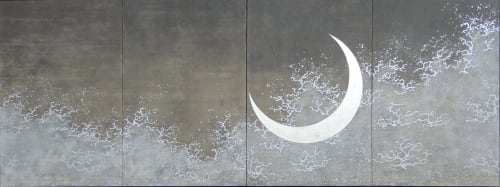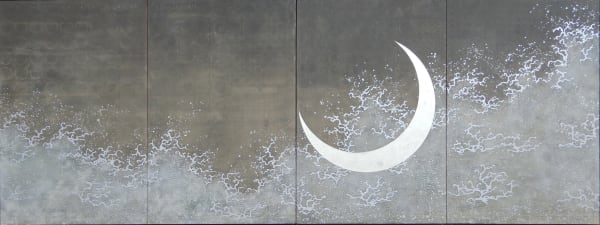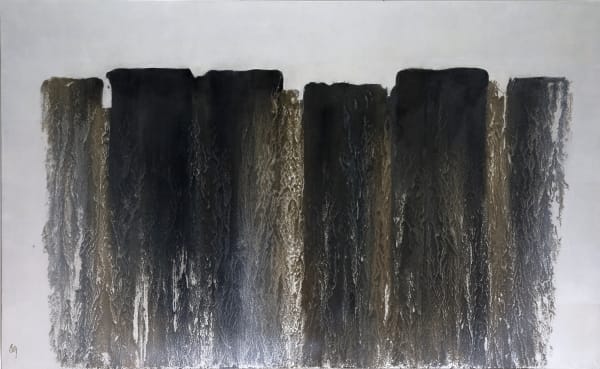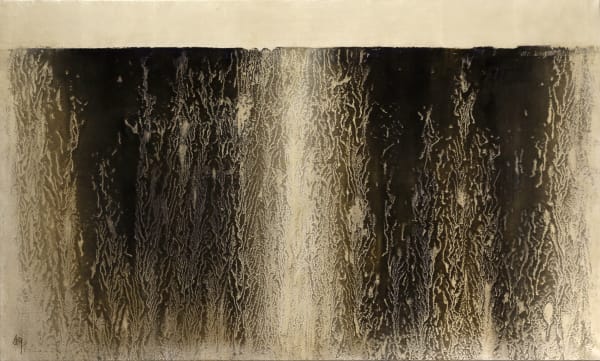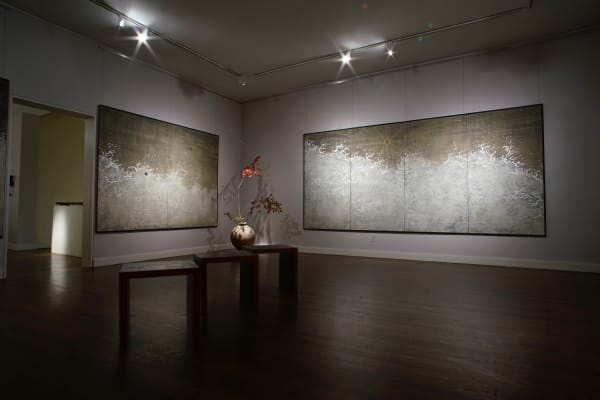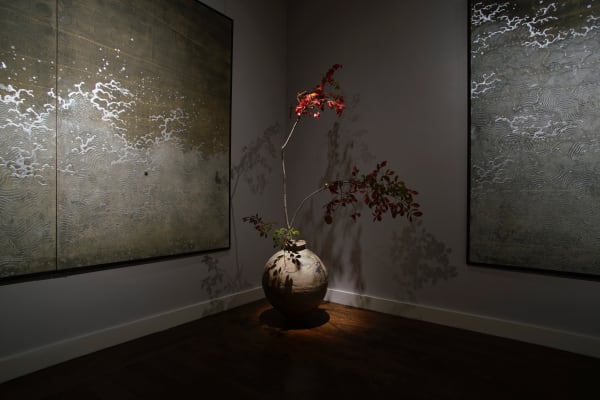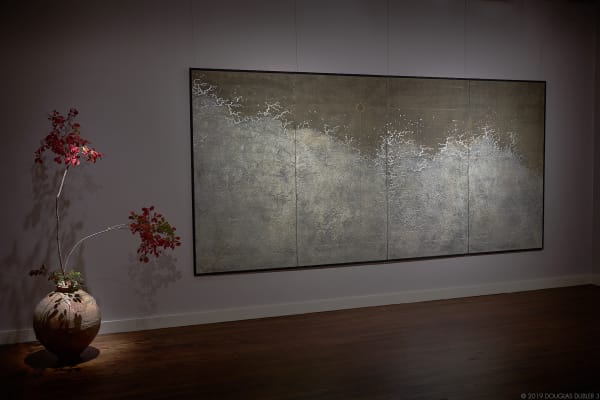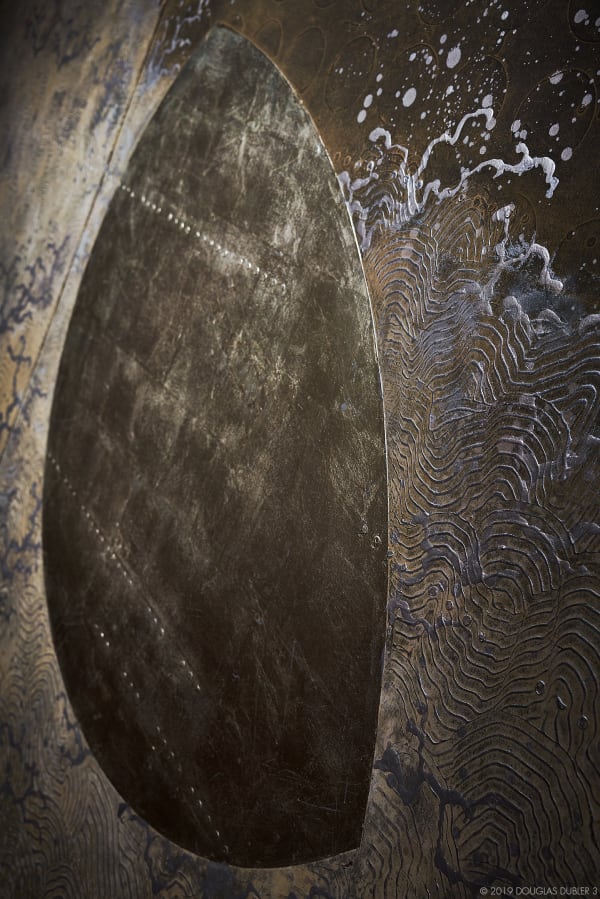Kukai : Sun and Moon : Paintings by Ken Matsubara | Grand Opening Exhibition at 32 E 67th street gallery
Benevolent Painting
The Kuroshio Current that flows along Japan’s south-eastern coastline creates powerful eddies around the sunken rocks while the raging waves thunder against the coast, raising fine spray. The sun rises in the sky, day by day, while at night the silver light of the moon shines through the darkness as it waxes and wanes.
It was to here, to this remote corner of Japan, that the young Kūkai came, his heart captivated by the mysteries of the universe as he sought to comprehend the unknowable enigma of life. He lived in a cave, reciting mantras, as he carried out his ascetic training, day and night.
1,200 years later, the painter Ken Matsubara visited the same spot in order to experience the same scenery as Kūkai. The ‘KŪKAI’ series that resulted from this experience consists of paintings on 24 sliding doors into which he single-mindedly devoted his whole being. We can almost hear the crashing of the waves as the sun and moon climb into the limitless skies. We can also experience the flash of light from Venus that was to shock Kūkai into enlightenment. Matsubara’s mentor, Sankō Inoue (1899–1981), said that an artist should not simply look at a subject, but try to enter inside it and Matsubara continues this practice today, working earnestly to interact with nature and people. When standing in front of his paintings, we are filled with a feeling of benevolence and a realization that it is fine for people to live as part of nature. His paintings represent a great affirmation of life.
We are extremely grateful to be able to open our new gallery with Ken Matsubara’s KŪKAI: Sun and Moon.
Shoko Aono
Ippodo Gallery celebrates its brand new location on 32 E 67th Street with a spectacular exhibition of paintings by Ken Matsubara from his “Kūkai’s View ‘Sun and Moon’” series. The concept for this series derives from the Heian period with the renowned Buddhist monk, poet and scholar: Kūkai (774-835). After training in the ways of Buddhism in China, Kūkai retreated to the caves of Muroto Cape in the Shikoku region of Japan to meditate. There, Kūkai saw nothing but sky, sea, and the cycles of night and day. He repeated the Buddhist Ākāśagarbha mantra endlessly until he felt at one with the natural cycles of the sun and moon he saw before him. It was here, at the young age of 19, that he achieved a flash of enlightenment and thereafter named himself Kū(Sky) Kai (Sea).
About 1200 years later, in 2015, Ken Matsubara also traveled to Muroto Cape to stay in the same caves. He wanted to form his own connection with the mind and experiences of Kūkai. For two years, he contemplated his vision for a painting. In January 2017, he started painting. In September 2017, the series was complete. On Echigo Washi paper, Ken Matsubara first applied a thin coat of red, bengala oxide for a more flexible and textured background. He then used a mixture of Yamashina earth with acrylic resin to produce his unique mud base, which he outlined with rich, sumi ink and silvery mica. The focus of each painting- the sun or moon - is made with gold or white gold for a lustrous depiction of the serene sky.
These paintings were originally commissioned as Fusuma doors by Seizo Hayashiya (1928-2017) who was the former director of the Musée Tomo, honorary member of Tokyo National Museum, and a great connoisseur of teaware. They were destined for the Jingoji temple where Kūkai stayed after returning from China with Buddhist teachings. However, as Hayashiya passed before the completion of the works, the series is now making its overseas debut at Ippodo Gallery, New York. Ken Matsubara’s painting have a quiet power that unites us with an intangible and universal energy. As an homage to his inspiration, underneath each panel is Matsubara’s favorite poem by Kūkai, ‘Hizo Hoyaku.’ The poem is a reminder of how little we truly know about ourselves in this grand universe.
In addition to the works pictured, there will be 15-20 more pieces, including his symbolic “Scenery (Kei)” series. This exhibtion will mark the grand opening of Ippodo Gallery New York’s new space on 32 E. 67th Street. It will be located on the third floor of an Art Deco building at a prime location in the art gallery district of New York. We hope to continue transmitting knowledge of Japanese culture in this new location through exhibitions of outstanding art-crafts created by contemporary artists, both now and into the future.
